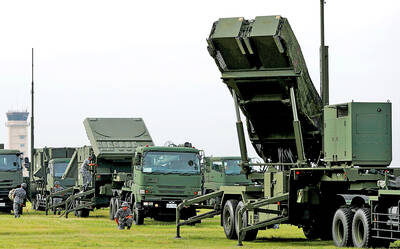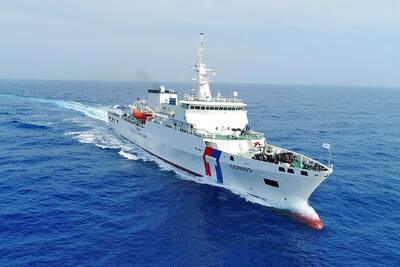The government’s decision to bring the defense budget to a five-year low is jeopardizing Taiwan-US military relations and future arms sales, and highlights longstanding questions about Taiwan’s commitment to self-defense, defense and foreign policy experts told a conference yesterday.
The Ministry of National Defense’s budget this year is NT$297.2 billion (US$9.2 billion), about 2.2 percent of GDP, despite a pledge by President Ma Ying-jeou (馬英九) to raise defense spending to 3 percent of GDP and calls from bipartisan -lawmakers to increase funding.
Less money in the budget has jeopardized defense projects and spending on new equipment and infrastructure, especially as the government moves to phase out conscription and implement an all-volunteer military.
Some military officials are admitting that a delay in the 2015 deadline for an all-volunteer force is in the works because of financial difficulties.
“There are officials in the US who are questioning Taiwan’s own defense commitment. And an important indicator of that is the defense budget — a method to clearly show the US Taiwan’s determination,” Joseph Wu (吳釗燮), Taiwan’s former representative to the US, told the conference in Taipei organized by the Taiwan Brain Trust think tank. “America’s willingness to strengthen Taiwan security ties is related to our own [commitment].”
At stake in the reduced defense budget, which has gradually been rolled back to 2006 levels as both a percentage of government spending and the total sum since a high of NT$349.5 billion in 2008, are the continued sales of large arms packages from the US to Taiwan.
Defense and foreign policy officials have for years lobbied for the sale of advanced F-16C/D multi-role fighter jets and diesel submarines, which were not included in the US$6.4 billion package announced by US President Barack Obama in January last year.
Military officials confirmed last week that they plan to axe a special fund set aside for the two items to a more “symbolic” figure of US$10 million.
Expressing concerns over such a move, former minister of national defense Michael Tsai (蔡明憲) said the decision would have far-reaching consequences for arms purchases over the next decade and the modernization of military hardware in the face of continued double-digit increases in the People’s Liberation Army’s budget.
Spurred in part by falling defense spending, but also the lack of a firm indication of any upcoming sales from the US, Tsai said the approach “will not only weaken Taiwan’s defense capabilities, but also deeply impact Taiwan-US military cooperation in the future.”
“Announcing only a symbolic figure for purchases of the [F-16C/Ds and diesel submarines] reveals a contradiction by President Ma, as he has previously advocated increased military spending of 3 percent of GDP annually ... this platform represents a shift in the balance of power across the Taiwan Strait,” Tsai said.
So far, there hasn’t been any indication from either defense or government officials on any major increases in military spending next year, amid generally warming ties with China.
Amid the reduced cross-strait tensions, there have been calls for the US to abandon Taiwan militarily, since there is a diminished chance of armed conflict with China, Wu said. Those calls have grown, not fallen, since Taiwan’s defense spending has been cut, Wu said, adding that Taiwan must showcase its commitment to self-defense.
In an article in the March/April edition of Foreign Affairs -magazine, Charles Glaser, a professor of international affairs at George Washington University, proposed abandoning Taiwan based on risks to the US by “ongoing improvements in China’s military capabilities [that] may make Beijing more willing to escalate a Taiwan crisis.”
While the rollback in defense spending has been gradual, it is significant when taken in the wider context of military funding by neighbors in the Asia-Pacific region.
Defense expert Su Tzu-yun (蘇紫雲) said Taiwan’s defense figure was especially sobering when compared with that in Singapore and South Korea.
Singapore, with one-fifth the population of Taiwan, spent US$9.5 billion on defense this year, with the gap between the two countries’ budgets expected to grow. South Korea and Australia spent US$25.9 billion and US$26.5 billion respectively, on their militaries this year, Su said, adding that this raised questions as to whether Taiwan faced any less of a threat.
“It doesn’t,” he said.
The balance of power against China, which spends 10 times as much on its military than Taiwan, “is skewed, and that invites aggression,” said Su, a former National Security Council researcher.
“The belief that economic cooperation prevents war is false,” he said, adding that despite improving cross-strait relations, Taiwan still needs to increase defense funding and press for more arms sales from the US — not just the F-16s — or it risked sending the wrong signal.

MILITARY BOOST: The procurement was planned after Washington recommended that Taiwan increase its stock of air defense missiles, a defense official said yesterday Taiwan is planning to order an additional four PAC-3 MSE systems and up to 500 missiles in response to an increasing number of missile sites on China’s east coast, a defense official said yesterday. The official, who spoke on condition of anonymity, said that the proposed order would be placed using the defense procurement special budget, adding that about NT$1 trillion (US$32,88 billion) has been allocated for the budget. The proposed acquisition would include launchers, missiles, and a lower tier air and missile defense radar system, they said The procurement was planned after the US military recommended that Taiwan increase

POLITICAL AGENDA: Beijing’s cross-strait Mid-Autumn Festival events are part of a ‘cultural united front’ aimed at promoting unification with Taiwan, academics said Local authorities in China have been inviting Taiwanese to participate in cross-strait Mid-Autumn Festival celebrations centered around ideals of “family and nation,” a move Taiwanese academics said politicizes the holiday to promote the idea of “one family” across the Taiwan Strait. Sources said that China’s Fujian Provincial Government is organizing about 20 cross-strait-themed events in cities including Quanzhou, Nanping, Sanming and Zhangzhou. In Zhangzhou, a festival scheduled for Wednesday is to showcase Minnan-language songs and budaixi (布袋戲) glove puppetry to highlight cultural similarities between Taiwan and the region. Elsewhere, Jiangsu Province is hosting more than 10 similar celebrations in Taizhou, Changzhou, Suzhou,

TWO HEAVYWEIGHTS: Trump and Xi respect each other, are in a unique position to do something great, and they want to do that together, the US envoy to China said The administration of US President Donald Trump has told Chinese President Xi Jinping (習近平) “we don’t want any coercion, but we want [the Taiwan dispute] resolved peacefully,” US ambassador to China David Perdue said in a TV interview on Thursday. Trump “has said very clearly, we are not changing the ‘one China’ policy, we are going to adhere to the Taiwan Relations Act, the three communiques and the ‘six assurances’ that were done under [former US president Ronald] Reagan,” Perdue told Joe Kernen, cohost of CNBC’s Squawk Box. The act, the Three Joint Communiques and the “six assurances” are guidelines for Washington

DEEPENING TIES: The two are boosting cooperation in response to China’s coercive actions and have signed MOUs on search-and-rescue and anti-smuggling efforts Taiwan and Japan are moving to normalize joint coast guard training and considering the inclusion of other allies, the Japanese Yomiuri Shimbun reported yesterday. Both nations’ coast guards in June sent vessels to the seas south of the Sakishima Islands to conduct joint training, the report said, adding that it was the second joint maritime training exercise since the nations severed formal diplomatic ties in September 1972. Japan dispatched the Nagoya Coast Guard’s Mizuho, a 134m, 6,000-tonne patrol vessel which can carry a helicopter, while the Coast Guard Administration (CGA) sent the 126m, 4,000-tonne Yunlin, one of its largest vessels, the report